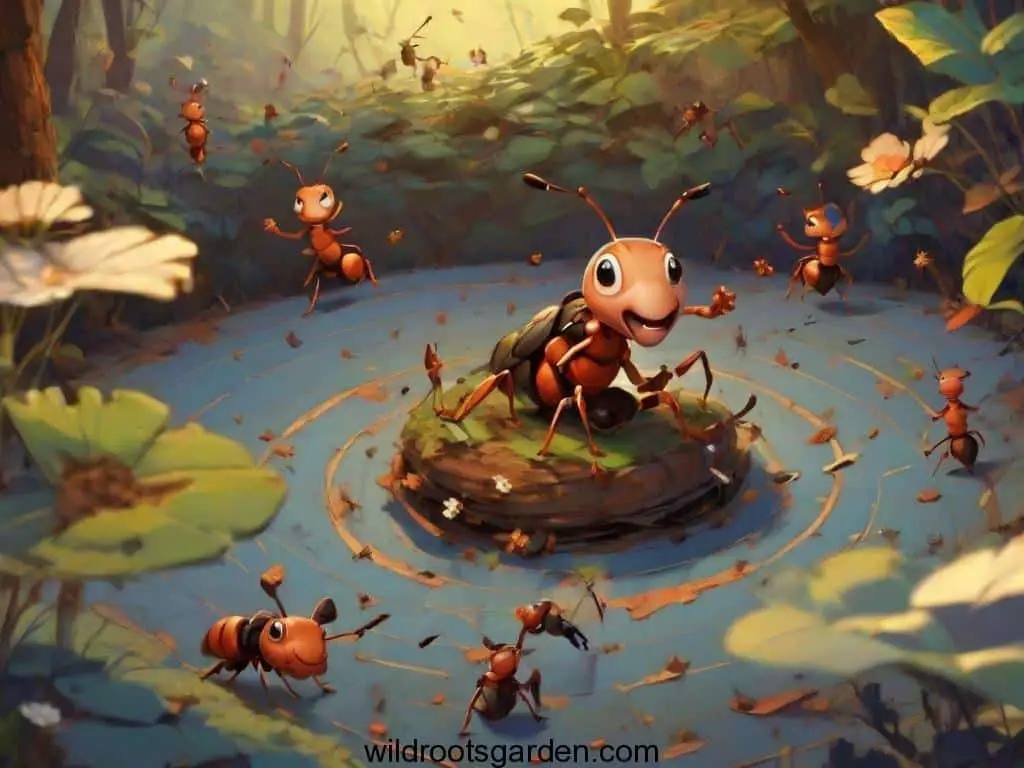Ants running in circles, often called an “ant mill,” is a phenomenon caused by the loss of the pheromone trail. It results in ants following each other, forming a continuous loop.
JUMP TO TOPIC
- 1 Table of Contents
- 2 Introduction To Ants Running in Circles Behavior
- 3 Scientific Explanations For The Phenomenon
- 4 Implications And Effects On Ant Colonies
- 5 Human Interpretations And Cultural References
- 6 Research And Future Directions
- 7 Conclusion: The Enigmatic Dance Of Ants
- 8 Frequently Asked Questions For Ants Running In Circles
- 9 Final Thoughts:
Table of Contents
Ant behavior is fascinating and complex, with ant mills being one of the more intriguing aspects. These circular patterns emerge when ants become disoriented and are unable to rejoin their colony. They rely heavily on pheromone trails to navigate, and when these trails get disrupted, an ant may inadvertently follow the scent of the ant ahead, leading to a futile cycle.
This circular march can prove fatal if the ants don’t break free from the loop. Studying ant mills reveals much about their communication systems and social structures, as ants are usually model examples of efficient, cooperative behavior. This striking behavior underscores the importance of trail pheromones in ant survival and direction, cementing their role as critical for the functioning of ant societies.
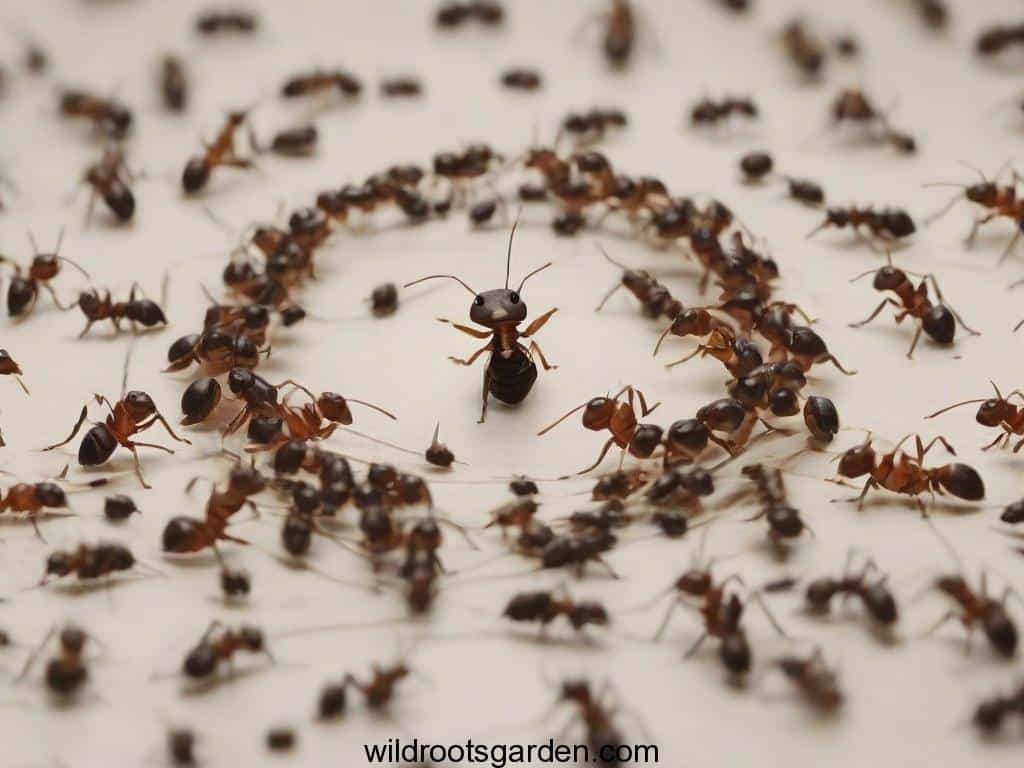
Introduction To Ants Running in Circles Behavior
Ants are fascinating creatures, well-known for their complex social structures and efficient foraging techniques. A peculiar phenomenon within the world of these industrious insects is ant milling, where ants are observed circling together in a seemingly endless loop. This behavior, although not common, sheds light on their communication systems and orientation mechanisms. In this article, we delve into what an ant mill truly is, the historical context, and the significance of understanding these movement patterns.
An ant mill is a behavior displayed by ants where they lose their pheromone trail and begin to follow one another in a continuous loop. The result is a large circle of ants, each blindly following the ant in front, leading to a situation where the group can ultimately succumb due to exhaustion. This phenomenon is particularly prevalent among the species that are highly reliant on pheromone trails for navigation and communication.
Documented by naturalists over the years, circular ant behavior or ant milling dates back centuries, highlighting an intriguing aspect of ant biology. Early observers were mystified by this self-destructive activity, which contradicted the usual perception of ants as models of hard work and organization. Their observations have led to a deeper exploration into the causes and mechanisms behind this bizarre behavior.
Examining ant movement patterns is not just a matter of scientific curiosity; it has practical implications. Insights into ant behavior can lead to breakthroughs in algorithms for robotics and computer science, particularly in the realms of navigation and autonomous systems. Additionally, understanding these patterns helps us comprehend the importance of communication in social insects and can be crucial in managing ant populations, which can be either beneficial or detrimental for humans.
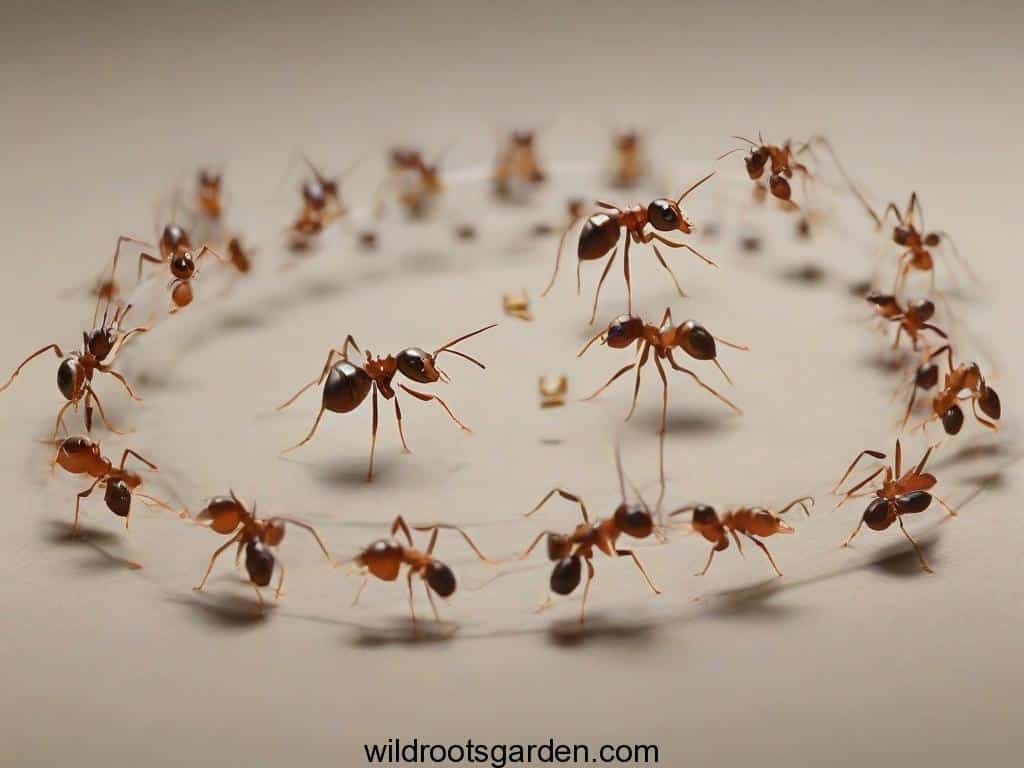
Scientific Explanations For The Phenomenon
Observing ants running in circles might seem amusing or even unnerving to some. But behind this seemingly erratic behavior lies intricate biological and environmental influences. Scientists have delved into this peculiar activity to provide fascinating explanations. Delving into the world of these industrious creatures, it’s clear that their actions are not random but influenced by complex factors we’re only beginning to fully understand.
The Role Of Pheromones In Ant Orientation
Ants are incredible navigators, largely reliant on pheromones to find their way. These chemical markers are essential for communication and orientation in the insect world. When an ant locates food, it leaves a pheromone trail on its way back to the colony, guiding others to the source. But what if these pheromone signals go amiss?
- Following stronger pheromone trails can lead to a loop.
- Over time, the ants reinforce these loops creating a continuous cycle.
- Disorientation occurs when the original path’s purpose no longer exists but the pheromone trail is still detectable.
The Theory Of ‘blind Leading The Blind’
This theory posits that a group of ants may become trapped following one another, with no clear leader guiding them. When the lead ant follows the scent and joins the back of the line, they form a continuous circle known as an ant mill. Without intervention, they can continue this cycle until exhaustion.
Environmental And Physiological Factors Contributing To The Behavior
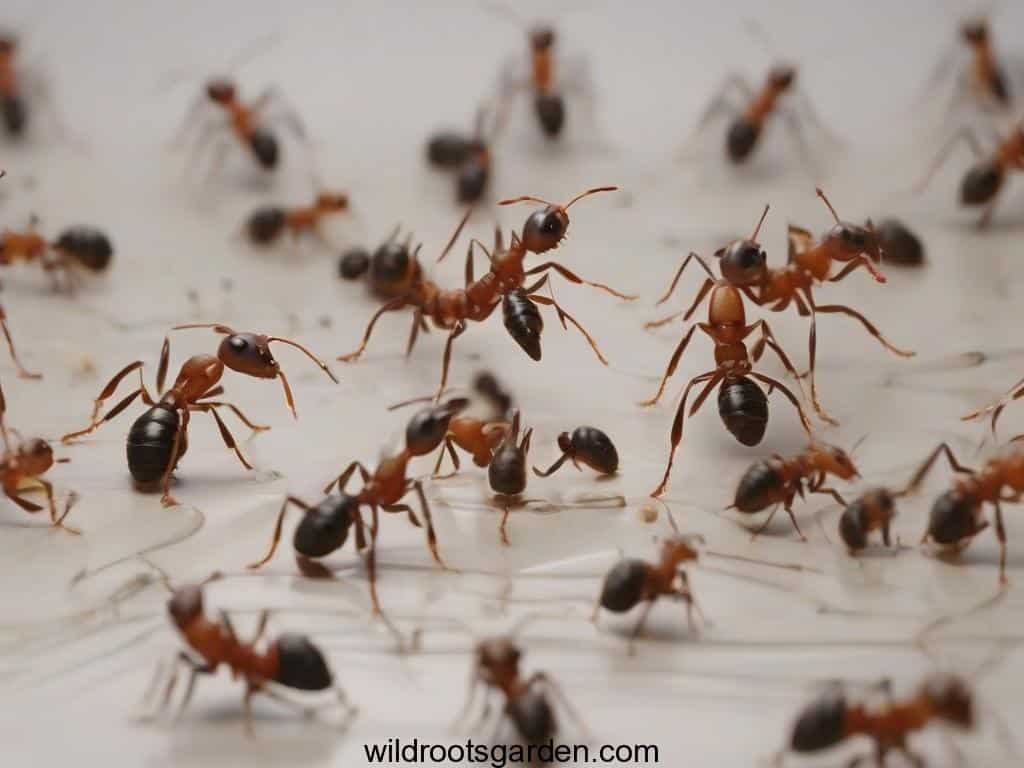
Beyond pheromones, various factors significantly impact ant orientation:
| Environmental Factors | Physiological Factors |
| Changes in terrainHindrances obstructing direct pathsWeather influences such as rain or wind | Vision impairmentAntenna damageExhaustion and depletion of energy reserves |
Each factor plays a role in altering natural behavior and can contribute to the formation of an ant mill.
Comparative Behavior In Other Species
Ants aren’t the only species exhibiting such circular behavior. Comparative studies have shown similar patterns in fish and birds, often related to disruptive environmental or social triggers. While the underlying causes might differ, the patterns we observe connect these species in a fascinating display of nature’s complexities.
Implications And Effects On Ant Colonies

Understanding the behaviors of ants and the complexities of their colonies uncovers a fascinating spectacle of natural coordination and survival strategies. However, certain behaviors, like ‘ant mills’ or ‘death spirals,’ where ants end up walking in endless circles until they perish, can have significant implications and effects on ant colonies. In this post, we delve into the potential dangers of this phenomenon, its impact on colony efficiency and survival, and the fascinating adaptive behaviors ants employ to regain orientation and sustain their communities.
Potential Dangers Of Ants Running in Circles
Ant mills occur when ants, particularly the army ants, which rely on pheromone trails, lose their track and begin following each other in a continuous loop. This behavior can lead to dire consequences:
- Exhaustion: Ants involved in the loop can become physically exhausted, ultimately leading to their demise.
- Resource Depletion: As ants circle incessantly, the consumption of nearby resources spikes, potentially exhausting supplies needed for the colony’s sustenance.
- Vulnerability to Predators: The predictable circular pattern makes ants easy targets for predators, endangering many members of the colony.
Impact On Ant Colony Efficiency And Survival
Ants are lauded for their efficient work ethic; however, ant mills can greatly disrupt the cohesion and functioning of their societies. This has several fallout effects:
- Disruption of roles and tasks, affecting the colony’s overall productivity.
- Reduced ability to defend the colony, repair nests, or care for the young.
- Depletion of the worker population can translate into a slower growth rate or even collapse of the colony.
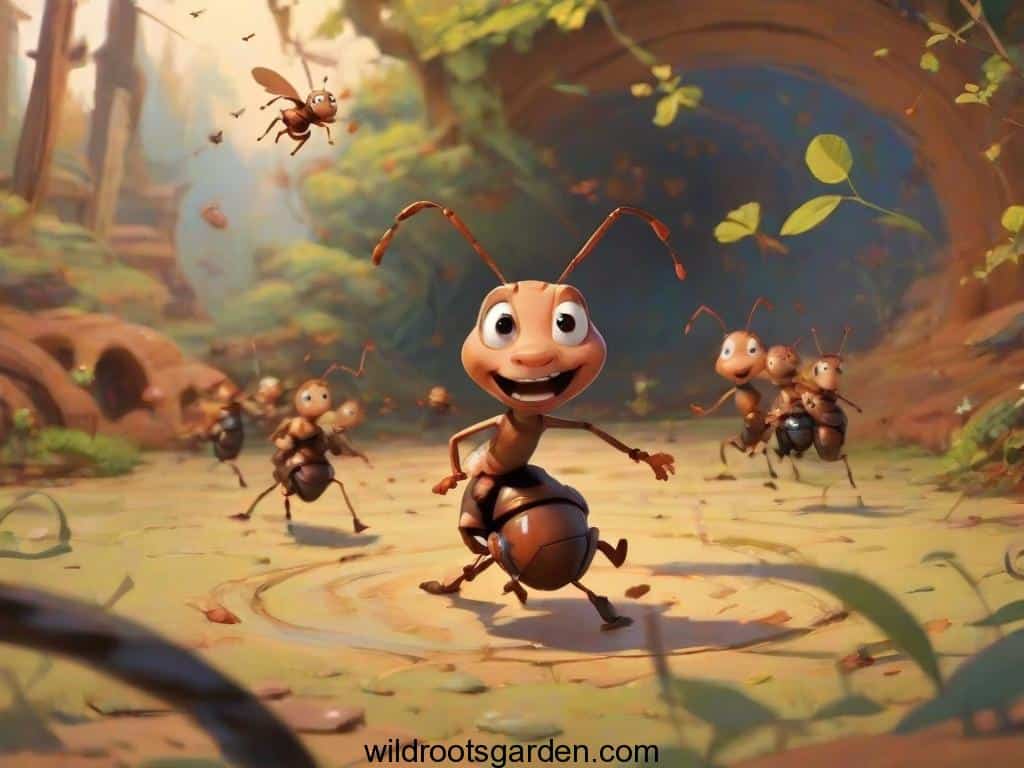
Adaptive Behaviors And Recovery From Disorientation
Fortunately, ants exhibit remarkable adaptive behaviors to counter the effects of disorientation:
| Behavior | Purpose | Outcome |
| Recalibrating Pheromone Trails | To re-establish a clear path for foraging ants. | Resumption of efficient resource gathering. |
| Rescue Operations | Free trapped ants from the ant mill. | Prevention of mass exhaustion and death. |
| Scouting Alterations | Send out new scouts to establish alternative routes. | Expansion of foraging territory and resource influx. |
In addition, ants can sometimes self-organize and disband the mill on their own, showcasing their complex communication and problem-solving abilities, which are crucial for the survival of the colony.
Human Interpretations And Cultural References
The sight of ants running in circles, often referred to as “Ants Running in Circles,” captivates and bewilders onlookers, opening the door to numerous human interpretations and cultural references. This phenomenon, in which ants follow each other in an endless loop until exhaustion, has long fascinated observers, leading to its inclusion in literature, art, and popular discourse. The metaphorical implications of this circular march have not escaped the notice of philosophers, writers, and artists, who find in it rich symbolism for human behaviors and societal constructs. Below, we delve into the various ways in which ant mills have woven their way into human thought and culture.
Ants Running in Circles In Literature And Popular Media
Ants Running in Circles often become central motifs in stories and films, symbolizing various themes from futility to the power of nature’s patterns. Literature uses these natural occurrences to create haunting images of never-ending struggle and the dangers of blindly following. Popular media, including movies and television shows, frequently use ant mills to illustrate the less-than-perfect aspects of characters’ own journeys or the cyclicality of certain plot points.
Metaphorical Uses Of Circular Ant Behavior In Human Contexts
Metaphors drawing from circular ant behavior seamlessly blend into human contexts, painting vivid pictures of repetitive processes or situations where progress seems elusive. Such comparisons can be found in:
- Corporate environments, where the “rat race” is often depicted as an ant mill, implying a lack of direction or purpose.
- Political commentary, where policymakers may be critiqued for following each other in circles, creating a deadlock situation.
- Social phenomena, where community behaviors are sometimes likened to ants following a trail that goes nowhere, illustrating conformity or lack of critical thinking.
Lessons From Ants Running in Circles: Insights Into Collective Behavior And Swarm Intelligence

Observing ant mills also yields valuable insights into the workings of collective behavior and swarm intelligence. Scientists and researchers find in these patterns lessons about communication, decision-making, and the balance between individual and group actions. By understanding the triggers and outcomes of such behavior, parallels are drawn to human crowds and organizational dynamics, suggesting ways to enhance cooperation and prevent “blind leading the blind” scenarios. These studies could lead to breakthroughs in various fields, from robotics to urban planning. Ant mills thus serve as a natural laboratory for understanding complex systems, inspiring innovation and adaptation in human endeavors.
Research And Future Directions
The phenomenon of ants running in circles, also known as an ant mill, presents a curious spectacle that has puzzled both the casual observer and the scientific community. Extensive research provides insights into this behavior, which seems to stem from the ants’ strong pheromone-following instinct combined with potential navigational errors. Investigating such phenomena not only enlightens us about ant behavior but could also yield significant implications for understanding collective movement in other species, including humans.
As we look forward, the integration of innovative methodologies and emerging technologies such as artificial intelligence promises to deepen our understanding and unveil new discoveries in the realm of myrmecology—the study of ants.
Methodologies In Studying Ant Circular Movements
Researchers employ various methodologies to study ant circular movements, often combining field observations with experimental simulations. Advanced techniques, such as motion capture systems and high-speed videography, enable the detailed analysis of individual ant movements within a mill. These studies are further supplemented by pheromone mapping and the use of ant colony simulations in controlled environments.
Current Limitations And Challenges In Research
- Environmental Variances: Field studies are often affected by unpredictable environmental factors, making controlled replication challenging.
- Data Complexity: The intricate nature of ant behavior demands sophisticated tools for capturing and analyzing high volumes of data.
- Ethological Constraints: Ethical considerations limit invasive research methods, thus complicating in-depth physiological studies on ants.
Future Research Questions And The Potential For Artificial Intelligence Applications

While current research has laid a robust foundation, many questions remain. Future directions include:
- Exploring how neurological mechanisms underpin ant circling behavior.
- Determining the precise role environmental factors play in initiating and sustaining ant mills.
- Assessing the impact of mill behavior on ant colony survival and productivity.
Moreover, the advent of artificial intelligence offers exciting avenues for research:
| AI Application | Potential Impact on Ants Running in Circles Research |
| Pattern Recognition | Identification of mill formations in their early stages through automated analysis of movement data. |
| Machine Learning | Develop predictive models of ant behavior based on large datasets, revealing insights into the emergence of circular movements. |
| Robotics | Implementation of ant-like robots to simulate and study mills without disrupting natural ant populations. |
In the quest to decode the mystery of Ants Running in Circles, a synergy between biological research and artificial intelligence promises to unlock new understanding and guide future scientific inquiry.
Conclusion: The Enigmatic Dance Of Ants
Ants Running In Circles, often referred to as ant mills, present a fascinating example of animal behavior that’s as mysterious as it is intriguing. This peculiar occurrence, where ants follow each other in an endless loop until exhaustion, allows us to peer into the complexities of collective intelligence and coordination. Through understanding this phenomenon, we acquire valuable insights not just about ants, but about the broader implications of animal behavior patterns and decision-making.
The ant mill is a result of the ants’ natural tendency to follow pheromone trails laid down by fellow colony members. In most cases, this mechanism allows for efficient food gathering and navigation, but when these trails accidentally loop back on themselves, an ant mill can form. This results in a spiral of death where ants march in circles until they perish from exhaustion. It’s a rare but captivating glitch in an otherwise astonishingly effective system.
Studying phenomena like ant mills extends beyond entomological curiosity or the plight of the ants themselves. It has the power to influence a wide range of fields, such as robotics, with algorithms inspired by ant behavior enhancing the efficacy of swarm robots. Additionally, these patterns can shed light on human behavior and crowd control, helping to prevent dangerous situations during mass gatherings by applying the principles learned from our six-legged counterparts.
- Robotic systems mimicking ant communication for improved autonomy.
- Human crowd management strategies drawn from ant traffic flow.
- Enhanced understanding of distributed intelligence and its applications.
The world of ants offers an exquisite glimpse into the realm of collective intelligence. Despite the occasional anomaly, such as the ant mill, the coordination and cooperation observed within ant colonies are nothing short of remarkable. The way these creatures communicate, make collective decisions, and optimize their roles showcases the sheer power of unity and efficient information sharing. Ant behavior exemplifies the elegance of evolution and the boundless potential of working together towards a common goal.
Frequently Asked Questions For Ants Running In Circles
What Is The Largest Ant Death Circle?
The largest ant death circle, also known as an ant mill, was observed at over 1,200 feet in diameter. Ants continuously circled until they perished from exhaustion.
Why Do Ants Move In Circular Motion?
Ants move in circles due to an error in their pheromone following behavior. An ant may lose the scent trail and inadvertently follow its own or another’s trail in a loop, creating a circular motion.
Why Do Ants Get Trapped In Pen Circles?
Ants can get trapped in pen circles due to the ink disrupting their pheromone trails, confusing their navigation and communication.
Why Do Ants Retrieve Their Dead?
Ants retrieve their dead to prevent disease and keep their colony clean. This behavior, known as necrophoresis, helps maintain a hygienic nest environment.
Final Thoughts:
Ants circling relentlessly captivates and mystifies. This odd behavior, known as ‘ant milling’, stems from their scent-following instincts. Understanding this phenomenon sheds light on complex social structures and survival tactics in the animal kingdom. So, next time you spot a march of ants in an endless loop, take a moment to appreciate these tiny creatures’ fascinating quirks.Their world is full of surprises, mirroring the intricacies of nature itself.
Here are some website resources about Ants Running In Circles, offering information from scientific explanations to practical solutions:
Scientific Explanations:
- National Geographic: https://m.youtube.com/watch?v=HbIVbEEYtKI – Provides a concise explanation of “ant mills” in army ants, attributing them to pheromone confusion and emphasizing the potential consequences.
- Scientific American: https://en.wikipedia.org/wiki/Ant_mill – Offers a more in-depth exploration of the phenomenon, discussing different causes like obstacle encounters and pheromone exhaustion.
- Entomological Society of America: https://entsoc.org/events – Features an article by an ant expert detailing the mechanics of ant mills and their occurrence in various ant species.
Practical Solutions:
- PestWorld: https://en.wikipedia.org/wiki/Ant_mill – Offers practical tips for disrupting ant mills and preventing their formation, including using water or insecticides safely.
- Ants: Myth & Pest Control: https://extension.umn.edu/insects-infest-homes/ants – Provides specific strategies for dealing with ant circles indoors and outdoors, including identifying the ant species and implementing targeted solutions.
- Bob Vila: https://en.wikipedia.org/wiki/Ant_mill – Shares simple household remedies to disrupt ant trails and discourage circle formation, including using cinnamon or citrus peels.
Additional Resources:
- Wikipedia: https://simple.wikipedia.org/wiki/Ant_mill – Provides a comprehensive overview of “ant mills,” including historical observations, causes, and various occurrences in different ant species.
- YouTube Videos: Several educational videos like “Ant Death Spiral Explained” and “Why Do Ants Walk in Circles?” offer visual explanations and close-up observations of ant mills.
- University Extension Services: Websites like those of the University of California and Texas A&M University offer pest control guides and specific recommendations for dealing with ant issues in your region.
Remember, encountering ants running in circles is more common than you might think. The resources above can help you understand the reasons behind this bizarre behavior and take appropriate action if necessary.
I hope this information helps!

